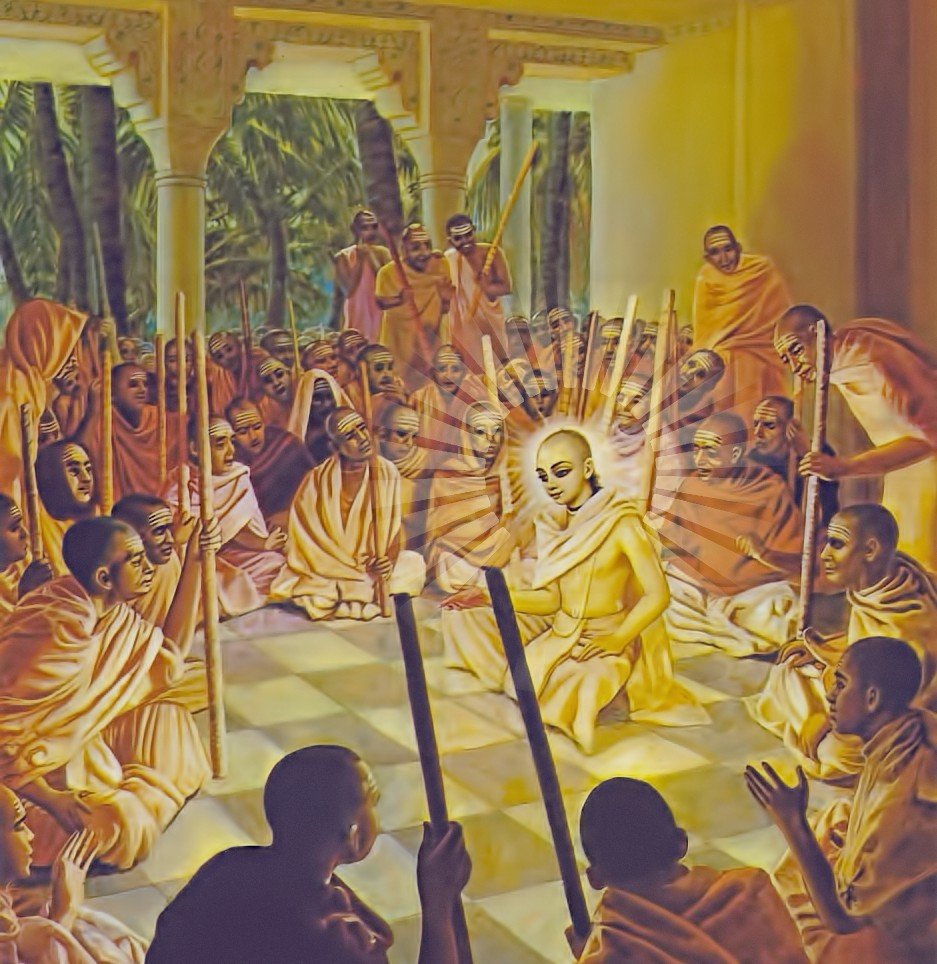Achintya Bheda Abheda Tattva


Lets try and understand what “Achintya Bheda Abheda” means.
The translation is “inconceivable oneness and difference”.
In Sanskrit achintya means ‘inconceivable’,
1 – bheda translates as ‘difference’,
2 – abheda translates as ‘non-difference’.
Lord Caitanya Mahaprabhu (1486–1534), the founder of the Achintya Bheda Abheda school and Gaudiya Vaishnavism
The Gaudiya Vaishnava religious tradition employs the term in relation to the relationship of creation and creator (Krishna, Svayam Bhagavan), between God and his energies.
This philosophy was taught by Sri Caitanya Mahaprabhu and differentiates the Gaudiya tradition from the other Vaishnava Sampradayas.
It can be understood as an integration of the strict dualist (dvaita) theology of Madhvacharya and the qualified monism (vishishtadvaita) of Ramanuja.
Historically within the Vedic teachings, there are two conflicting philosophies regarding the relationship between living entities (Jiva-tattva, jivatma or jiva-soul) and Lord Krishna (God) the Supreme Personality of Godhead and cause of all causes.
“Advaita schools” assert the monistic view that the individual jiva-soul and God are one and the same.
Whereas “Dvaita schools” give the dualistic argument that the individual jiva-soul and God are eternally separate.
The philosophy of Achintya-bheda-abheda includes elements of both viewpoints.
The individual jiva-soul is intrinsically linked with the Supreme Lord, and yet at the same time is not the same as God.
The exact nature of this relationship being inconceivable to the human mind.
All individual jiva-souls are considered to be part and parcel of the Supreme Lord like the connection between the the sun-rays and the sun disc, forever joined and inseparable.
The jiva-souls are the same in “quality” but not in “quantity” of God or Krishna.
Krishna is the Supreme Personality of Godhead and has all opulences (64) in fullness (100%).
However, the individual jiva-souls have only a partial expression of His divine opulence (50 of Krishna’s 64 qualities or opulences, which is 78.125% of Krishna’s qualities or opulences.
Another analogy in this context is God or Krishna is compared to a fire and the jiva-souls are compared to sparks coming off of the flame.
The theological tenet of achintya-bheda-abheda tattva reconciles the mystery that Krishna is simultaneously “one with and different from His creation”.
In this sense, Vaishnava theology is panentheistic as in no way does it deny the separate existence of God (Krishna, including His Vishnu and Narayana expansions that all have 60 of Krishna’s 64 opulences or 93.75%) in His own personal form.
However, at the same time, creation (or what is termed in Vaishnava theology as the ‘cosmic manifestation’) is never separated from Krishna.
Krishna as His different expansions always exercises supreme control over his creation.
Sometimes directly, but most of the time indirectly through his different potencies or energies (Prakrti).
Examples are given of a spider and its web; earth and plants that come forth and hair on the body of human being.
“One who knows God (Krishna) knows that the impersonal conception and personal conception are simultaneously present in everything and that there is no contradiction.
Therefore Lord Caitanya established His sublime doctrine: acintya bheda-and-abheda-tattva that means simultaneous oneness and difference.” (Srila A. C. Bhaktivedanta Swami Prabhupada)
The analogy often used as an explanation in this context in the relationship between the Sun and the Sunshine mentioned above.
For example, both the sun and sunshine are part of the same reality, but there is a great difference between having a beam of sunshine in your room, and being in close proximity to the sun itself.
Qualitatively the Sun and the Sunshine are not different, but as quantities they are very different.
This analogy is applied to the individual jiva souls and Krishna – the Jiva-soul being of a similar quality to the Supreme being Lord Krishna, but not sharing the same qualities to an infinite extent, as would the Supreme Personality of Godhead himself has.
Thus there is a difference between the jiva-souls and the Supreme Personality of Godhead Lord Krishna.
Difference in concept to Advaita Vedanta.
It is clearly distinguished from the concept of anirvacaniya (inexpressible) of Advaita Vedanta.
There is a clear difference between the two concepts as the two ideas arise for different reasons.
Advaita concept is related to the ontological status of the world, whereas both Svayam bhagavan and his saktis (in Lord himself and his powers) are empirically real, and they are different from each other, but at the same time they are the same. But that does not negate the reality of both.
Exceptions.
While it applied to relations between Purusha (the Lord) and Prakriti (be it material, marginal, or spiritual powers), in the theology of the concept there are areas of exceptions.
Jiva Goswami also accepts that any object and its energy are non-different, such as fire and power of burning.
While some maintain that its only a secondary extension of the principle that it is primarily applied to Svayam bhagavan and His energies.
It does not, however, apply to differences between Avatars of Svayam bhagavan and Lord Himself, so the difference between Krishna and His origin, is not covered by the concept of acintya bhedabheda, i.e. it cannot be applied in cases where different levels of Purusha are compared.
This is a difficult subject to understand, and by strictly chanting 16 rounds of the Hare krishna mantra, and engaging in devotional service, will eventually allow us all to understand what is written here.
DISCLAIMER: The author is solely responsible for the views expressed in this article. The author carries the responsibility for citing and/or licensing of images utilized within the text.
